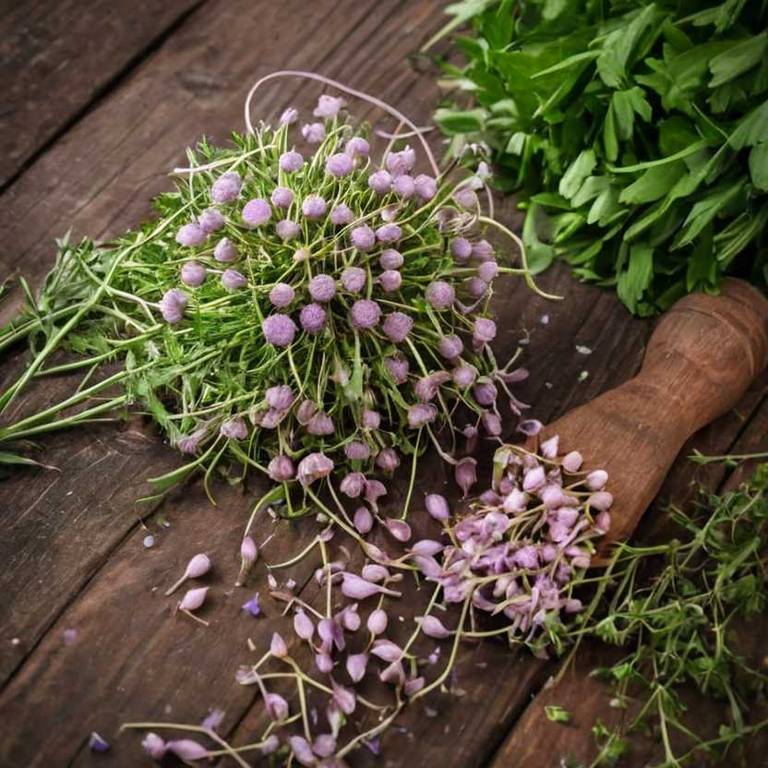By Leen Randell
Updated: Jul 21, 2024
10 Medicinal Constituents Of Allium Schoenoprasum (Chives)

Allium schoenoprasum has active constituents such as flavonoids, vitamins, and minerals, including vitamin K, vitamin C, and potassium.
These constituents contribute to its medicinal properties, including antibacterial, antifungal, and anti-inflammatory effects.
The presence of these properties can improve lives by aiding in wound healing, reducing inflammation, and boosting immune function, as seen in cases of improved digestion and reduced symptoms of IBS.
This article explains in details the 10 best active constituents of Allium schoenoprasum.
1. S-allyl cysteine
Allium schoenoprasum s-allyl cysteine is a unique compound found in its leaves and stems.
This sulfur-containing amino acid has been extensively studied for its potential health benefits, including antibacterial, antifungal, and anti-inflammatory properties.
S-allyl cysteine has also been shown to have antioxidant activity and may help protect against certain diseases, such as cardiovascular disease and cancer.
2. Quercetin
Allium schoenoprasum quercetin is a flavonoid compound that has been isolated from its leaves.
This bioactive molecule has been reported to exhibit various biological activities, including antioxidant, anti-inflammatory, and antimicrobial properties. Quercetin has been shown to possess potential health benefits, such as protecting against oxidative stress, reducing inflammation, and exhibiting antiviral and antibacterial effects.
Its unique chemical structure makes it an attractive candidate for the development of new therapeutic agents.
3. Kaempferol
Allium schoenoprasum kaempferol is a type of flavonoid compound that has been isolated from its leaves.
Kaempferol has been found to exhibit various biological activities, including antioxidant, anti-inflammatory, and antimicrobial properties. It has been reported to have potential health benefits, such as preventing cancer, cardiovascular disease, and neurodegenerative disorders.
Further research is needed to fully understand the effects of kaempferol from Allium schoenoprasum on human health.
4. Isothiocyanate
Allium schoenoprasum isothiocyanate is a bioactive compound responsible for its characteristic pungent and savory flavor.
It is derived from the breakdown of sulfur-containing amino acids in the plant's cells upon damage or chewing.
This volatile molecule has been reported to possess various health-promoting activities, including antioxidant, anti-inflammatory, and antibacterial properties, making it a valuable component in traditional medicine and cuisine.
5. S-methyl cysteine
Allium schoenoprasum s-methyl cysteine is a bioactive compound found in its leaves and flowers.
This sulfur-containing amino acid has been studied for its potential health benefits, including antimicrobial, antifungal, and antioxidant properties.
S-methyl cysteine may also have anti-inflammatory effects and has been shown to possess insect-repellent and plant growth-promoting activities, making it a valuable component of traditional medicine and agricultural practices.
6. Diallyl sulfide
Allium schoenoprasum diallyl sulfide is a sulfur-containing compound responsible for the characteristic flavor and aroma of these culinary herbs.
It has been extensively studied for its potential health benefits, including antibacterial, anti-inflammatory, and antioxidant properties. Diallyl sulfide has been shown to have anticancer effects, inhibit platelet aggregation, and reduce cholesterol levels.
Its therapeutic applications are being explored in various fields, including medicine, food processing, and cosmetic industries.
7. Allyl mercaptan
Allium schoenoprasum allyl mercaptan is a volatile sulfur compound responsible for its pungent and characteristic aroma.
This compound is released when the herb is chopped or crushed, releasing the enzyme alliinase, which breaks down the amino acid sulfoxide into allyl sulfide and acrylate.
The combination of these two compounds creates the distinctive "onion-like" smell of chives, which is a key factor in their flavor and aroma profile.
8. Glucoraphanin
Allium schoenoprasum glucoraphanin is a sulfur-containing compound found in its leaves and flowers.
This potent bioactive has been extensively studied for its health benefits, particularly its role in preventing cancer. Glucoraphanin exhibits powerful antioxidant properties, neutralizing free radicals and reducing oxidative stress.
Its sulforaphane derivatives have also shown anti-inflammatory and antimicrobial effects, making it a valuable component of chive's nutritional profile.
9. Sinigrin
Allium schoenoprasum sinigrin is a unique compound found in its leaves and flowers.
It is a type of glucoside, responsible for the pungent, slightly sweet flavor and aroma that chives are renowned for. Sinigrin has been traditionally used in folk medicine to treat various ailments, including digestive issues and inflammation.
Its antioxidant properties also contribute to the plant's potential health benefits when consumed as part of a balanced diet.
10. Flavonoids
Allium schoenoprasum flavonoids is a group of plant compounds that have been identified in its leaves and flowers.
These bioactive molecules are responsible for the herb's antioxidant, anti-inflammatory, and antimicrobial properties.
Flavonoids in chives have been shown to possess potential therapeutic effects, including reducing oxidative stress and improving cardiovascular health, as well as exhibiting antibacterial activity against certain foodborne pathogens.